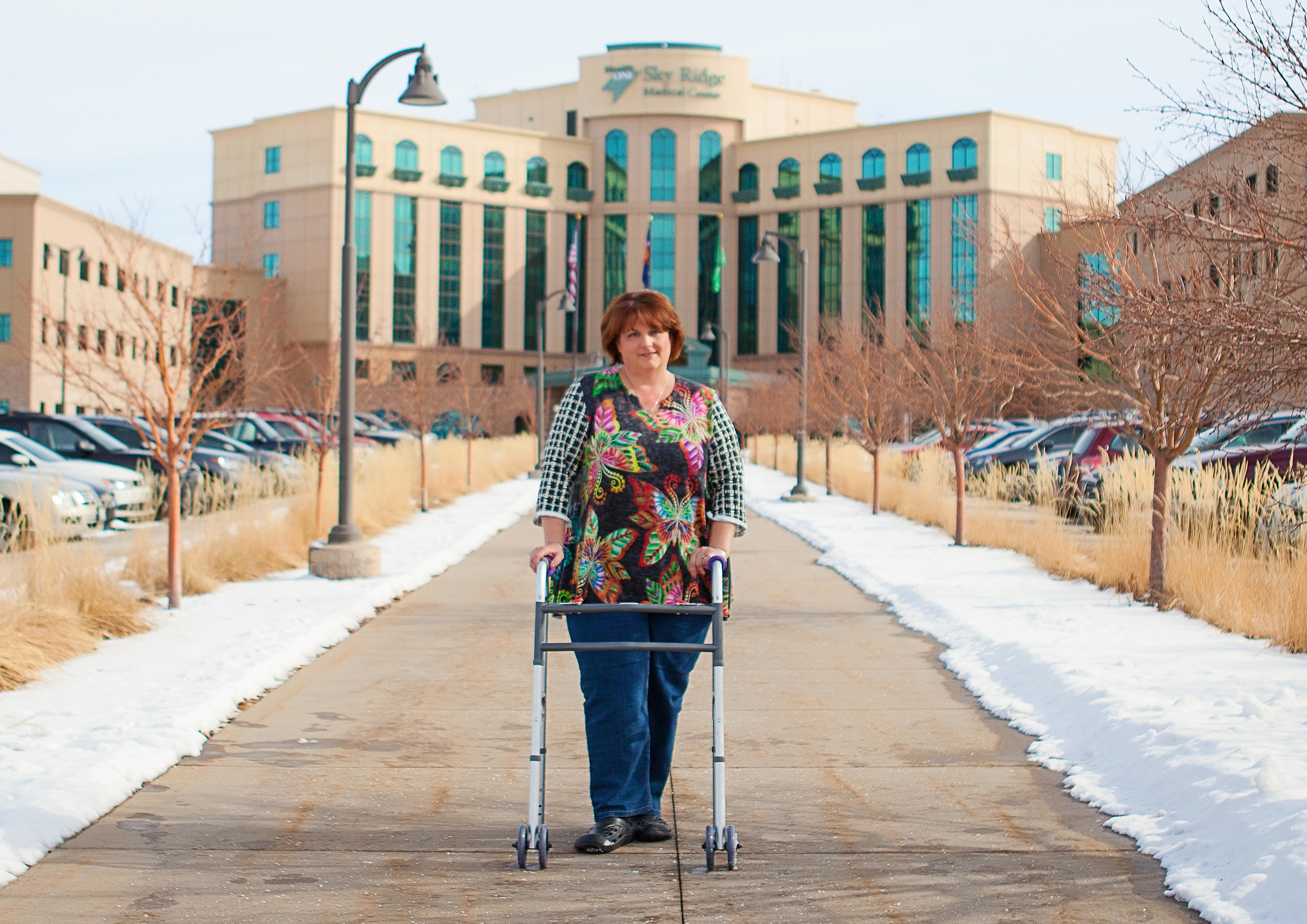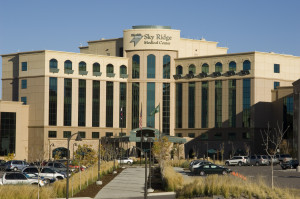When timing is critical | by

Sky Ridge trauma-level boosts care for patients closer to home
At first, she screamed, sure her husband of 22 years was dead. Pete Campbell, who had just entered a business zone on the way back to the couple’s Castle Rock home from an evening drive, had passed out at the wheel. Then, survival mode kicked in, and Deidra Campbell unbuckled her seatbelt, slid across the bench seat of the Ford 150 truck, and steered the 2- ton vehicle back onto the road just as it was about to jump a curb and head toward a McDonald’s. As she maneuvered through traffic, she tried to push her husband’s foot off of the gas pedal, but his leg wouldn’t budge. With his dead weight accelerating the truck to nearly 70 miles per hour in the 35-mph zone, and drivers blasting their horns as she narrowly missed their vehicles, Campbell saw the end of the road. She had a choice: a concrete barrier or a massive mound of dirt. She chose the dirt.
Witnesses say the dirt on the construction site acted like a ramp, catapulting the truck high in the air before it dropped into a 10-foot-deep hole on the other side. That’s where the emergency crew found the couple. When her husband came to, he was barely hurt, thanks to his seatbelt and air bag. But Deidra Campbell, 49, suffered severe trauma, her legs mangled in the impact, her body wedged so tightly first-responders had to cut her out of the vehicle.
As with any trauma, time was of the essence, and just days before, Sky Ridge Medical Center, only minutes away, had been approved as a Level II trauma center capable of taking her case. To earn the designation, hospitals must meet state criteria that assure they can rapidly treat and stabilize any traumatic injury. And when it comes to trauma ̶ the top killer of Americans between the ages of 1 and 46, according to the Centers for Disease Control and Prevention ̶ the faster the treatment at a higher level of care, the higher the chance of full recovery.

Deidra Campbell (shown with her husband, Pete) was one of the first patients to benefit from Sky Ridge Medical Center’s new level II trauma designation.
Emphasis on readiness
“It’s called the golden hour,” Sky Ridge Medical Center’s Chief Medical Officer Dr. David Markenson says of the hour post-injury, when trauma specialists work to have a patient not just in a hospital, but on the operating table when necessary to boost chances of survival. “In a trauma system, every minute counts,” Markenson says. Before the new designation, ambulance drivers with severely injured patients would have rushed right past Sky Ridge toward the next nearest high-level center at least 15 miles away, which, with Denver traffic, could be significant. “Can you imagine someone who was hit near Sky Ridge at 4:30 in the afternoon and had to travel on I-25? That could be an hour drive on some days,” Markenson says.
Instead, Campbell was transported within minutes of being freed from the vehicle to Sky Ridge, where Trauma Director Randi Koehn’s 10-member trauma team, already prepped on Campbell’s status and ready for her injuries, was waiting. “We greeted her when she arrived and immediately started stabilizing her,” says Koehn, whose nurses are certified in advanced life support and trauma care. “We transport patients in and out of the trauma bay quickly.”
With two broken legs (one badly fractured), a broken sternum, bruises on every part of her body, and one side of her face severely swollen, Campbell remembers being scared and in a lot of pain. “I looked like Quasimodo with one eye about to pop out of its socket. But they were doing everything they could do for me. I remember the staff explaining everything that was going on and being so kind,” says Campbell, who, while still recovering and largely wheel-chair bound weeks after the accident, is confident of a full recovery.

Deidra Campbell thanks trauma director Randi Koehn, who led Campbell’s care the night a relaxing ride turned into a harrowing nightmare for Deidra and her husband.
Staff of experts
Level II centers must have the staffing and advanced equipment needed to treat and stabilize any severe trauma (Level I centers, the highest level, must meet the same requirement but also have the capability of supporting any follow-up care needed.) For Level II status, trauma and specialty surgeons must be on the floor within a 15-minute period, a requirement Sky Ridge exceeds. “We decided it was important to have both a trauma surgeon and anesthesiologist on staff rather than on-call with operating-room and surgical capability 24/7,” Markenson says.
Sky Ridge also has an Intensive Care physician on staff at all times and a full cadre of experts ready on short notice to treat highly-complex trauma cases, including radiologists, neurosurgeons, plastic surgeons, orthopedic surgeons and a team of noted interventional radiologists, who can perform treatments rapidly and minimally-invasively using catheters and computer-assisted image guidance.
Once Campbell was stabilized and other internal injuries ruled out, she was evaluated by Dr. Scott Resig, an orthopedic surgeon who specializes in complex lower-extremity cases. “He came in and said, ‘We are going to take you to surgery, and I’m going to piece your leg back together,’” Campbell says. “Later, when I saw the X-ray with all the screws and plates, I said: He really DID piece it together. It was amazing.”

Did you know? A national evaluation published in the New England Journal of Medicine in 2006 concluded that having a high-level trauma center in a community can reduce deaths by as much as 25 percent.
Beyond the ER
Being an elite trauma center involves more than having top ER care, something most people don’t realize, Koehn says. “It includes everything from surgery and rehabilitation to prevention education and getting patients back into the community,” she says. “It goes well beyond the ambulance and the trauma bay.” Earning the Level II designation improves each aspect of a trauma program, which benefits all trauma patients, not just those who require Level II care, Markenson says.
Campbell, who developed Post-Traumatic Stress Disorder after her intense experience, says Sky Ridge helped her through all of her physical and emotional issues, from rehabilitation to PTSD treatment. Nightmares of the final moments before the crash ̶ a torrent of dirt and darkness intermingled with light ̶ repeatedly woke her up the first nights in the hospital, and staff was always there, she says. Campbell says she’s thankful for Sky Ridge’s new designation, and she’s really grateful for her husband (whose medical evaluations revealed a heart murmur, which doctors are treating), and for their unusual decision to drive their son’s big truck that night. “It saved our lives.”
Top traumas at Sky Ridge Medical Center
- Falls (mainly 65 and older) Top causes: Steps, tripping in middle of night with no light
- Motor Vehicle Accidents Top causes: Ice in winter, driving too fast for conditions, distracted driving
- Bicycle Accidents (mainly mountain bikers) Top causes: Falls from hitting rocks or logs
By the numbers
- In the United States each year, trauma cases account for:
- 41 million emergency-room visits
- 2 million hospital admissions
- 192,000 deaths
(Centers for Disease Control and Prevention)
Tags: Sky Ridge Medical Center Level 2 Trauma Care
Leave a Comment
Please be respectful while leaving comments. All comments are subject to removal by the moderator.
